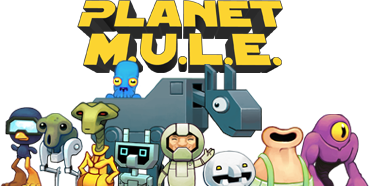|
Keybounce
|
 |
« Reply #2 on: March 27, 2011, 20:32 » |
|
In a "real" economy, you have largeness. You cannot be shut out of food or energy. Therefore, you do not need to make your own.
In MULE, however, the economy is tiny. 4 people normally, 5 in the new. You can be shut out.
Because of this, because you are totally dependent on food, because you can find yourself after turn 4 with no food, and no one selling you food, you are in a position of "I must have food of my own".
Energy is similar. It's not nearly as critical, because if you have food and no energy, you can plop down some energy mules, and be back in two turns. But you cannot recover from no food unless the other players let you recover. And energy killing in round 10 or 11 is basically game over.
Food is particularly problematic in original mule. A single river plot will take care of you for about 2/3rds of the game. There's enough river spaces for people to each get one, and there's no big incentive to get two. If you do get two, then you are producing 4 + 4 + 1 + 1 = 10, but have a need of much, much less. So what do you do with the surplus? When the store values them at 15? When players see the 15 and won't give a reasonable offer? When even if the players do give a reasonable offer, the store still thinks that the surplus is worthless?
Most people wind up not even bothering to sell the surplus, and letting it spoil.
If you don't get a river, you need 2 land plots; that's enough to generally drop you a full +1 for volume on your mining. And, not only is a single river not enough late in the game, you risk the "mule runs away", or food pests, or an energy shortage killing that particular mule, etc.
So if you cannot trust other players -- ** and in a game design that deliberately says food is not regarded by the game as valuable as mining then you cannot trust the other players ** -- you have to have two food plots just be be self reliant, and a food producer strategy is a waste because even if you are serious and trustable, no smart player will. And energy isn't that far off from this either.
Hence, the RPS cycle: A self reliant producer will survive if there is a backstabbing provider. They will lose to a non-self reliant producer with a trustable provider. The non-self-reliant producer will lose to the trustable provider if there are enough non-self-reliant producers that the provider can turn constant profits. And the provider will lose if people go self reliant and not use the provider.
Everyone being dependent on each other? Generally, in mule 1, I see the store bought out of food and energy by turn 2, usually of smithore on turn 1. People horde, and make their own food or energy *in the mountains*. It's all about "Grab land that will become great, but start with just bare survival".
And money isn't in Crystite in mule 1; it's in smithore manipulation. That already seems to be going away in mule 2 (quakes don't ruin crystite; store fires don't jack up smithore prices).
===
The idea for the mechanic is simple: Have a threshold dollar amount that the colony has to reach before a winner is determined. If the colony fails to reach it, EVERYONE takes a loss, even the "winner". The reasoning for it is simple: 1: Encourage more cooperative play, and 2: Increase the number of options / playstyles that the game can support. Right now, with all the advice being "shut the other person out and make it pointless for them to continue", well, yea, you'll get the higher score, but is the colony really doing well? Does the other person want to continue, or drop and let a bot flounder in that spot?
|
